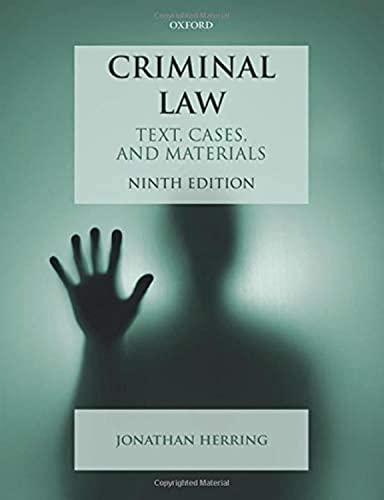Question
Read the Case thoroughly and then review and answer the Questions below within this document. CASE SUMMARY: [Pursuant to a divorce decree, wife Melinda acquired
Read the Case thoroughly and then review and answer the Questions below within this document.
CASE SUMMARY: [Pursuant to a divorce decree, wife Melinda acquired a three-quarter interest in the family home as Tenant in Common with her ex-husband, James. Under the same decree, James moved out, and Melinda lived on the property with her adopted son, West, plaintiff herein. Melinda gave West a deed to the entire property (although she only owned three-quarters), which he duly recorded. Six years later, West married and moved out, leaving Melinda the sole occupant until her death. During Probate, West claimed the entire property, three-quarters by Deed and the other quarter by Adverse Possession. Defendants (James' heirs Evans) claimed that the quarter interest could not be acquired by adverse possession because the possession was not open and notorious and additional because the possession was not hostile. The latter contention was based on the theory that West was a cotenant, and possession by one cotenant is possession by all cotenants. All other elements of adverse possession were met]
THE COURT: To establish title by adverse possession, the claimant must establish five elements in connection with his occupancy of the property (1) possession must be actual occupancy under such circumstances as to constitute reasonable notice to the owner. (2) Possession must be hostile to the owner's title. (3) The holder must claim the property as his own either by color of title or claim of right. (4) Possession must be continuous and uninterrupted for five years. (5) The possessor must pay all the taxes levied and assess upon the property during the period. Unless each of these elements is established by the evidence the plaintiff has not acquired title by adverse possession.
Actual possession means a subjection to the will and dominion of the claimant. It is established not alone by the assertion of title. It must be coupled with acts of ownership that proclaim to the world and bring notice to the owner, that a right is claimed in the land over which the claimant is seeking to exercise dominion. But in the present case, there was no change in possession at any time after the date of the interlocutory (divorce) decree. Melinda continued to live on the property until her death in 1944 and West occupied it with her until his marriage in 1937. To the public generally, and to the heirs of James, after the date of interlocutory decree when the cotenants (heirs) acquired title, there was no indication of any change in possession by Melinda.
The testimony of West conclusively negates his claim that, at any time prior to 1944, he had actual possession of the property. From 1917 until the date of her death in 1944, Melinda stayed in the home. During the 20 years following 1917, he lived with her. Upon his marriage in 1937, he "moved off gradually". Referring to that time, he declared: "She didn't want anybody to live with her and she didn't care to live with any of her relatives". She said, 'This is my home and I want to stay right here".
The evidence conclusively establishes that for many years West paid the taxes on the property, but such payment is not an act of ownership equivalent to possession. The payment of taxes is an additional requirement for the acquisition of title by adverse possession.
The exclusive occupancy by a cotenant is deemed permissive; it does not become adverse until the tenant out of possession has had either actual or constructive notice that the possession of the cotenant is hostile to him. West argued that the recordation of the deed in 1931 constitutes such notice. However, the recordation of a deed purporting to convey the entire property in land to a tenant in possess is not, as a matter of law and independent of any other fact, notice to his cotenant of the adverse character of the grantee's possession. The only act upon which West can rely to give notice of his claim of ownership is the recordation of the deed in 1931, and such recordation alone is not sufficient for that purpose. The evidence is undisputed, and it does not show the elements that the law requires for establishing such title.
The judgment is reversed...The plaintiff West did not acquire title by adverse possession.
Questions regarding the case:
- Name all the participants mentioned in this case and what is each of their respective relationship to the ownership of the Family home?
- How are the parties currently claiming title ownership and under what kind of title holding? Explain how this type of Title holding works when held by multiple persons and how did the transfer of ownership rights to the Plaintiff and Defendant take place?
- What Legal Ownership concept regarding the Property was the Plaintiff trying to prove and on what grounds?
- Based on your understanding of the evidence presented in this case, does any or all of the five "Elements" required for this concept apply to these circumstances and explain why?
- What was the conclusion made by the Court in this case? What was the determining factor? Who owns what portion of the property after the final judgement? Was there something the Plaintiff could have done in the past to strengthen their case?
Step by Step Solution
There are 3 Steps involved in it
Step: 1

Get Instant Access to Expert-Tailored Solutions
See step-by-step solutions with expert insights and AI powered tools for academic success
Step: 2

Step: 3

Ace Your Homework with AI
Get the answers you need in no time with our AI-driven, step-by-step assistance
Get Started


